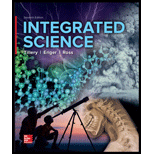
(a)
The type of the reaction
(a)
Answer to Problem 9PEB
The reaction
Explanation of Solution
In reaction
(b)
The type of the reaction
(b)
Answer to Problem 9PEB
The reaction
Explanation of Solution
In reaction
(c)
The type of the reaction
(c)
Answer to Problem 9PEB
The reaction
Explanation of Solution
In reaction
(d)
The type of the reaction
(d)
Answer to Problem 9PEB
The reaction
Explanation of Solution
In reaction
(e)
The type of the reaction
(e)
Answer to Problem 9PEB
The reaction
Explanation of Solution
In reaction
(f)
The type of the reaction
(f)
Answer to Problem 9PEB
The reaction
Explanation of Solution
In reaction
Want to see more full solutions like this?
Chapter 9 Solutions
Integrated Science
- 4. For the reaction, H2 + Br2 2HB1, a proposed reaction mechanism is given below: Br2 → 2Br. (fast) Br. + H2 – + HBr + H. (slow) Br2 + H. HBr + Br: (fast) Br + Br- Br2 (fast) If the above reaction mechanism is correct, what will be the rate law for this reaction?arrow_forward3. Which of the following is a fusion reaction. "Na +a → "Mg+H "N+a » "O+ H 222 Rn +a+Y 20 a. 11 12 b. 14 с. 88 86 d. H+"C→ "N H+H→He+ Energi e. Note : energi is energyarrow_forwardYou decide to have hot dogs for dinner. In the grocery store, you find that buns come only in packages of 12, whereas the hot dogs come in packages of 8. How can your purchases lead to having no buns or hot dogs left over? (How does this problem fit in with chemical bonding and other parts of this chapter?)arrow_forward
- Do covalent compounds conduct electricity when they are mixed with water? Explain.arrow_forward13. Complete the following equations: [5] 233 Np 23 Pu + 93 → 94 32 15 P→>> + +je+v P -1arrow_forward7. What is meant by the term coordination number in the structure of a solid? How does the coordination number depend on the structure of the metal?arrow_forward
- 6. 1 _+ 8n C+H> 7. 110BA → e + 56Ba >arrow_forwardIn a dissociative substitution reaction, the intermediate is а. paramagnetic b. of higher coordination number than that of the starting materials. c. diamagnetic. d. of lower coordination number than that of the starting materials.arrow_forward10. A certain heat engine draws 500 cal/s from a water bath at 27°C and transfers 400 cal/s toa reservoir at a lower temperature. The efficiency of this engine is: a. 80% b. 75% c. 55% d. 20%arrow_forward
- Methane, CH4, is the simplest hydrocarbon molecule and in its natural state is a gaseous substance. If you had 64 grams of methane, how many moles of methane would that be? Group of answer choices A. 1 B. 2 C. 4 D. 8arrow_forwardList all possible levels which results from a. L= 3, S= 5/2 –F, b. L= 2, S = 1 → D. ng e mearrow_forwardQuestion 9 Two white powders were mixed together. Achemical reaction occurred, and a yellow powder was formed. What is the relationship between the yellow powder and the white powders? The yellow powder is made up of the same kinds of atoms as the white powders, but the atoms are combined into different molecules. The yellow powder is made up of the same kinds of molecules as the white powders, but the molecules are a different color. The yellow powder was released from inside the atoms of the white powders. There is no relationship between the yellow powder and white powders. ©2021 lluminate Education TM, Inc. 10arrow_forward
 An Introduction to Physical SciencePhysicsISBN:9781305079137Author:James Shipman, Jerry D. Wilson, Charles A. Higgins, Omar TorresPublisher:Cengage Learning
An Introduction to Physical SciencePhysicsISBN:9781305079137Author:James Shipman, Jerry D. Wilson, Charles A. Higgins, Omar TorresPublisher:Cengage Learning
